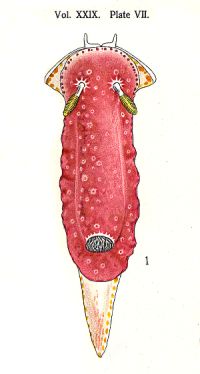Chromodorid from South Australia
August 21, 2001
From: John Chuk


Dear Bill,
I'm sending in situ images of another chromodorid that I am unable to identify. They are of two specimens photographed on 19 February 2001 at Rapid Bay Jetty, South Australia. Both were found beneath the end of the jetty at a depth of 9m.
Both specimens are very similar, only differing in size and the number of spots on the mantle. The pattern and coloration is somewhat diffuse giving the specimens an out of focus appearance. The mantle is somewhat translucent with a pinkish tinge and has small red spots on it that have pale areolae. Opaque white mantle glands form a band to the mantle. There is also a submarginal band of scattered orange-red spots. The gills and rhinophores are translucent. The gills are tinged pink on their inner edges.
The first image is of a specimen, 7 mm in length, found wandering over filamentous algae. The second image is of a specimen, 5mm in length, found on what appears to be a red Darwinella sp. sponge. On a later dive I found two more specimens of the same species on a similar sponge suggesting that it may be the food source.
When I found them on the dive I thought they could be a variation of Noumea haliclona but inspection of the slides made me doubt that identification. What do you think?
Thanks again for all your help!
Best Wishes,
John.
jchuk@giant.net.au
Chuk, J., 2001 (Aug 21) Chromodorid from South Australia. [Message in] Sea Slug Forum. Australian Museum, Sydney. Available from http://www.seaslugforum.net/find/5009
Dear John,
South-eastern Australia is the home of these red-spotted chromodorids and some species have different colour patterns in different parts of their geographic range. I am pretty sure your photos are of Chromodoris epicuria which changes from a species in which lines dominate the colour pattern in Victoria across to South Australia where the background can become quite pink, the lines disappear and spots predominate.
I have included alongside Basedow's painting [Pl.7, fig 1] which illustrated Basedow & Hedley's original description of this species. There are two species, C. multimaculosa and Noumea spencerensis which I need to add to complete the picture concerning these southern red-spotted species.
Best wishes,
Bill Rudman
Related messages
-
Re: Chromodoris multimaculosa from Bicheno, Tasmania
From: Capt John Silberberg, May 31, 2010 -
Re: Chromodoris multimaculosa from Bicheno, Tasmania
From: Greg Close, May 31, 2010 -
Chromodoris multimaculosa from Bicheno, Tasmania
From: Capt John Silberberg, May 29, 2010 -
Can you please id this nudi?
From: Trevor McMurrich, October 26, 2006 -
Chromodorid from S.E. Australia
From: John Chuk, June 26, 2002 -
Chromodoris epicuria from South Australia
From: Stuart Hutchison, March 8, 2002
